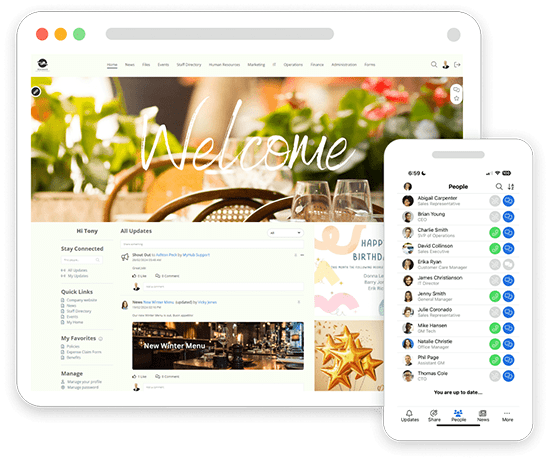Internal Communications In 2024
Build An Internal Culture Of Engagement And Focus
Share. Engage. Align

Internal communications in the workplace has undergone enormous change. Technology, remote working, globalization and flat structures have led business owners to rethink how they communicate with staff.
This communication revolution is happening across businesses of all sizes as employers seek better ways to connect with staff. And staff seek ways for their ideas to be heard.
Here we focus on why good internal communications matters, and how best to go about it.
What Is Internal Communications In 2024?

Internal Communications (IC) is keeping employees informed and connected to your business. It’s about ensuring decisions, programs, policies, goals, and company vision are shared with staff. It’s about giving staff a platform for their ideas and feedback.
Internal communications flows in all directions – top-down; sideways; bottom-up – and in multiple forms. And while some companies will have unique communication requirements, many share almost identical communication tasks. These often include Human Resources updates, leadership news, operational communications and inter-team collaboration.
Done well, internal communications fosters employee loyalty, belonging, and a shared sense of purpose. Employees feel valued. They understand where they fit and how they can contribute. Staff retention improves, as does overall business performance. Done poorly, staff feel disconnected, mistakes are made and projects fail. Lack of direction increases risk and staff turnover.
11 Reasons Why Internal Communications Is Important

To succeed in business today requires a healthy appetite for innovation, agility, and adaptability.
Leading staff on this never-ending journey of change requires strategic thinking, creativity and even mind-reading skills!
That’s why now, more than ever, organizations are looking to revamp or upgrade their internal communication efforts in order to inspire staff to ‘join the journey’.
Here are 11 reasons why good internal communications is important in business today.
1. Internal Communications Keep People In The Loop
To ensure your people are rowing in the same direction, information must be communicated across the entire business in a consistent way. This forms the structure of a well-functioning organization – otherwise your team is left paddling around in circles, getting nowhere fast.
A well-thought-out internal communications strategy allows you to build support for exciting new products, milestones, and initiatives. It provides a single source of truth (which stops internal confusion). And it reinforces internal culture aligned to your business strategy.
In light of the new hybrid world of remote-and-on-site working, businesses are trying harder than ever before to improve communications. Messages must have cut-through and clarity.
We must accept those spontaneous-yet-valuable water-cooler conversations are now rare, and the communicator’s favorite – the ‘town-hall’ meeting – is a thing of the past.
Consequently, communicators are rethinking how best to connect with staff, to keep them close to and interested in the business.
2. Internal Communications Achieves Company-wide Goals

Good internal communications will drive the right outcomes for your business. Employees want to understand what their role is, how this contributes to the big picture, and ultimately what that big picture is.
Done right, your staff will reach their potential as they will genuinely feel valued and engaged.
Clear goal-setting from the top will ripple through to every department and team member. This helps staff to discern which tasks to prioritize and improve their productivity.
Consider too that almost 100 percent of employees believe that communication influences all tasks daily. That’s why communication that supports the overarching goals will ensure the right work gets done.
3. Internal Communications Promotes Camaradarie
Everybody wins if they feel part of a good team. Multi-way communication between staff, managers, and interdepartmental colleagues helps everybody feel like their input matters. It can also prevent company knowledge from becoming siloed and untapped. This is more important nowadays with remote working widely in place.
Keeping information flowing to home-based workers is essential for staff to feel connected and cared for.
Communicating progress helps maintain momentum to get projects across the line. And importantly, nurtures a true team spirit for ongoing success.
4. Internal Communications Enhances The Employee Experience

We all spend a lot of time at work, so providing the best experience possible will make for happy, productive staff. But research suggests that employees spend on average 2.5 hours a day searching for information. This leaves staff feeling frustrated and ineffective.
Employee experience differs from employee engagement: the former is how an employee ‘feels’ as a result of every interaction with their employer (location, tools, meetings) whereas employee engagement is how an employee ‘responds’ to their employer (participation, social, tasks).
Good internal communications can enhance the employee experience by helping staff feel connected with the important stuff. Making it easy to find information is a start.
Inviting staff to share their feedback and ideas on proposals and decisions will foster a sense of worth.
The modern-day intranet has come a long way since its inception, featuring many social sharing features to truly impact the employee experience.
5. Internal Communications Engages Staff
Once upon a time, internal communications was thought to mean ‘emails from the CEO’. Thankfully, that’s all changed. Technology has paved the way for effective multi-way communication – downward, upward, and lateral – giving everyone a chance to participate.
Forums, blogs and chat channels are just some of the internal communication modules that enable lateral conversations – and increases engagement.
While likes, comments and shares are popular tactics that show interest and readership.
Furthermore, there’s increasing evidence that younger generations expect (and thrive in) a lateral, collaborative workplace. Engaged employees are more likely to express opinions and participate in work conversations, leading to fresh ideas and a greater chance of success.
6. Internal Communications Promotes Culture
A good company culture breeds open-mind thinking. All ideas are respected. Staff feel involved, enthusiastic and committed to their work.
But creating the perfect workplace culture can be a tough nut to crack. It’s the sum of many parts, least of which is how the company’s values, mission and goals are articulated and interpreted.
Setting the right tone, providing relatable examples, showing progress, and using multi-channel communication formats all help grow a strong culture that staff feel part of.
A multi-touch internal communications approach ensures all personality types are covered.
Providing staff with communication tools that will help them collaborate with their peers and managers in a way that suits them – whether they’re an extrovert, introvert, or in-between – breaks down barriers and gives everyone an equal voice.
Quizzes, surveys, instant messaging groups, discussion forums – these are just a few of the tools that can feed a healthy culture and make everyone feel involved.
7. Internal Communications Stops Time-Sucking Rumors

Humans love a grapevine. But as we all know, this type of informal communication can be full of holes and inaccuracies – and almost impossible to reign in once it starts.
Grapevines are caused by under-communication: a universal business challenge that’s been around for decades.
What’s changed now though is that people turn to other ‘information’ sources (think: social media) – it’s human nature to delve for answers, and form one’s own conclusion.
Particularly during uncertain times, staff will crave information. In the absence of accurate updates, staff may become anxious and less productive, and start to speculate (example: an innocuous on-site meeting with ‘business consultants’ that erroneously snowballs into a ‘redundancy and restructure’ session, if under-communication is at play).
A proactive internal communications program that pre-empts staff worries will ensure there’s a single source of truth. (note: perceptive skills – sometimes considered as mind-reading skills – is a quality often found with great communicators, as they sense and dispel rumors quickly).
8. Internal Communications Retains High Caliber Staff
Research suggests the top three reasons why people do not like (and subsequently quit) their jobs are communication-related: constant change that’s inadequately communicated; a lack of direction from management; and poor communications overall.
Losing staff can be a major blow to the bottom line. The financial cost of recruiting and onboarding new staff can be many thousands of dollars. In a recently published report it can cost up to of six to nine months of average salary to replace an employee factoring training and recruitment costs
So it makes good financial sense to address these communication challenges and suppress the brain drain from your business. Share important information with staff and let them play a more active role in the decision-making process.
9. Internal Communications Improves Reputation
A well-oiled communication program can quickly deal with the inevitable hiccups that come with running a business.
For example, a poor customer review on a high profile social media site can be extremely damaging if left untended. But if the correct communication processes are in place, the problem can be rapidly investigated, resolved, and explained back to the customer.
Remember that better communication and internal processes cut down on mistakes or gaps occurring in the first place.
Additionally, if staff feel in the dark and therefore disengaged, they’re more inclined to bad-mouth their employer to anyone who’ll listen: family, friends, and even customers.
10. Internal Communications Maintain Calm During Crisis

When a crisis strikes, there is immediate pressure for leaders to communicate. People want information and guidance. How companies communicated with their staff during the incomparable Covid-19 crisis is one for the history books. There were some exceptional leaders who stepped up to the executive communication challenge, choosing truth and openness. They delivered their comms at pace and with candor, not shying away from those ‘difficult-to-have’ conversations.
These leaders earnt the support and respect of their teams. Push-back was minimal as people understood the background to decisions and adapted to the required changes.
11. Internal Communications Increases Revenue
A recent Gallup study revealed striking evidence that underlined just how much dollar difference good internal communications can make.
Employees who are engaged have lower absenteeism rates and have far higher productivity. These workers are also more likely to stay with their employers.
Furthermore from an earlier study, highly engaged teams achieve a 10 percent increase in customer ratings and a 20 percent increase in sales!
Creating an ‘all-ideas-welcome’ atmosphere creates fertile ground for free-thinking and innovation.
This, in turn, is likely to drive business growth and ultimately increase revenue.
The Changing Face of Internal Communications

Too much technology, distributed teams, and an unrelenting pace of progress has created a chaotic setting for many workers. Important information gets lost amongst the noise. Emails fail to get through.
No wonder staff feel bewildered, overwhelmed, and out of the loop.
And employers feel no-one is reading their carefully-crafted corporate communications.
Meanwhile, it’s estimated that by 2022, 133 million new jobs may be generated from the adoption of robotics and algorithms, while 75 million jobs may be displaced, according to a report from the World Economic Forum.
With teams less likely to be sitting under the same roof, a growing cohort of remote and/or freelance workers, the traditional town-hall meeting is not so easy.
There is growing appreciation that successful internal communications today is hard work.
Employee communications are no longer the monthly “all-staff email” from the CEO.
There’s no silver bullet. No set and forget. It’s an ongoing process that continuously needs effort, time and resources.
With employee engagement at an all-time low – only 23% of employees feel involved and enthusiastic about – (source: Gallup – Global Workplace 3 Key Insights), there’s never been more drive to solve the communication challenge.
Today, the focus is on providing a positive employee experience; a large part of that is giving the right information, at the right time, targeted to the right individual. Wherever they may be.
❝
Seventy-four percent of staff feel they miss out on important company information
Source: www.gallup.com
Today’s Internal Communications Challenges
Distraction
Staff encounter noisy, open-plan environments and are surrounded by devices constantly pinging for their attention
Blurred Lines
Personal and professional content cross over as employees typically use the same mobile device to access work and private content 24/7
Distributed Workforce
The gig economy, a world-wide pandemic and advances in tech, has seen an increase in remote workers, which can lead to employees feeling isolated
Shrinking Attention Spans
Experts believe the human brain’s attention span has shifted from 12 seconds to 8 seconds in the past 20 years
Information Overload
The average knowledge worker is expected to process the equivalent of 174 newspapers each day!
Restricted Access
Approximately 80% of the global work workforce is deskless (think retail and manufacturing staff, nurses, drivers and emergency services) limiting the channels to reach staff
What Do Employees Want?
Most employees crave information about where they work – after all, it’s where they spend the majority of their time. As such, they’re curious about the inner workings of a company, from business strategy and company goals, to training opportunities and what’s being pushed out across social media.
They have a deep, personal interest in many of the decisions at stake. It’s why they value the opportunity to feedback, debate and discuss. It’s essential to let them share their voice.
Traditional communication methods still carry weight, for example face-to-face meetings, town hall gatherings, company networking events, and more.
But technology is breaking new ground that’s empowering staff to get involved in the conversation like never before.
In order for staff to do their job well, they expect:
- Fast, easy access to accurate information in just a few clicks
- Visually-rich, interactive and easy-to-follow digital experiences
- Instant messaging functionality with colleagues (emails are considered old-fashioned)
- Flat structures and therefore access to all staff – including the CEO (younger employees have grown up in a world where direct contact with the President of the U.S.A. is possible with a simple tweet!)
- Two-way communication – so that employees can listen and be heard
- Gamification – such as quizzes and leaderboards, recognition, and rewards
Consider too that employees have different communication styles and learning preferences – such as visual, auditory, reading/writing and kinesthetic – all of which need to be catered for. Hence the growth in video, interactive content and podcasts.
There is so much to be gained from internal communication tools capable of meeting these preferences, that businesses are failing their staff if they do not take action.
Who Is Responsible For Internal Communications?
Today, everyone has a role to play. Communications is not the one-way, top-down street it once was. All employees should be sharing ideas, collaborating with colleagues and providing feedback to help the company succeed.
However, every team needs leadership. And the strategic vision of this leadership needs sharing. In larger companies, this lies with the C-Suite, responsible for guiding culture, growing the employer brand, and ensuring staff are kept informed.
On behalf of management, the creation and execution of such messaging often sits with an internal communications team or a public relations team. These are skilled at writing and producing creative content.
In smaller companies, it may be the CEO or the human resources executive responsible for internal communications.
In both cases, large or small, effective internal communications is done best when it’s an interdisciplinary effort including the CEO and the C-suite; departmental managers; and all employees. After all, communications plays such a pivotal role in how employees regard and advocate for their employer, and how invested they become.
Key Benefits of Effective Internal Communications
Organizations that understand the benefits of internal communications inspire a constructive, open workplace where different departments all have a shared sense of purpose.
Improved business performance is the sum of many parts which include:
Company Culture
Better ways to inform, update, and celebrate achievements
Innovation
Great ideas can come from anywhere – not just the boardroom – if staff have the right channels to make suggestions
Knowledge United
Facilitate unified working, remove silos and share knowledge throughout
Employee Engagement
Staff understand the big picture, the meaning of their work, and the value they add
Change Management
Clear, reliable, unambiguous communications minimizes confusion and garners internal support
Employee Experience
Motivate, engage, inspire, involve staff to feel part of something special
Employee Retention
Studies show that retention levels could be 44% higher through effective internal communication
Compliance
Employers have a responsibility to ensure staff are trained on legislation
Reduce Email Volumes
Co-ordinated, fresh-format messaging saves the bloated, largely unread inbox
What Is An Internal Communication Plan?
An internal communications plan provides a roadmap to ensure staff are informed about important company information. Without this, it is easy to become distracted from the core goals and almost impossible to defend its value.
A plan helps to focus on specific areas that need addressing. This may comprise of: company goals, company updates, kpis, leadership communications, new initiatives, staff news, crisis communications, marketing campaigns, culture communications, company performance and more.
Essentially, it should include the following:
Analysis of the current state of the business, and its future plans
- What the internal communications plan will accomplish organizationally
- Who the audience is
- What the messages are, broken down by key topics
- How messages will be shared, using a range of tools, tactics, and channels
- Timing and duration of when messages will be sent
- Performance analysis to identify what’s getting cut through and what’s not
How Can IC Build Workplace Culture?
A company’s culture is what makes it unique. Almost everything else can be copied by a competitor. Developing that uniqueness can attract and retain talent, win customers, and grow the business.
How staff interpret each company message will affect workplace culture.
A poorly written email, an insensitive remark on the company intranet, or radio silence on an important topic can damage internal culture. That’s why a key purpose of an internal communications strategy is to manifest a healthy culture.
This can be achieved with the right tone, messaging, delivery, and format. But it doesn’t stop there.
Culture is also interpreted in the company news that’s shared – and what’s omitted – the truthfulness and transparency of a company, what its values are, and why that matters.
Communicating your values and culture must be continuous. And this doesn’t have to be boring! For example, creating short and quirky staff videos showing fun ways of exemplifying your company culture could resonate well. Staff blogs, internal quizzes, and surveys can help reinforce culture.
Appointing representatives with good communication skills from around the business will do wonders for creating a thriving company culture.
Good Internal Communications At Times Of Crisis
Pandemics, extreme weather, economic recessions … life doesn’t always go to plan. Businesses are impacted. Difficult – and sometimes fast – decisions have to be made. This is when effective communication is needed the most.
Don’t wait until an emergency or unexpected incident strikes before putting a crisis communications plan.
In the hour of need, it’s essential to have the right communication channels – poised with pre-populated, emergency content – ready to go. This saves time and error during an already challenging time.
Communications around redundancies and structural changes must also be handled with care. The morale of all staff – along with the company’s reputation – is on a knife’s edge. (Read the best way to deliver bad news to employees). Transparency, consistency and compassion form internal communications best practices when it comes to explaining tough calls.
The more open and communicative and organization is – particularly around sensitive topics or difficult news – the more united its workforce becomes.
Raising Internal Communications Standards To Meet Staff Expectations
Technology apps pervade every aspect of modern living. Social media posts, instant messaging, podcasts, webinars, and live-streams are exciting formats in which we consume content.
It’s no surprise that employees expect a feature-rich, engaging digital experience in their professional lives, similar to what they’ve become accustomed to in their private lives. In other words, workplace technology has been consumerized.
The responsibility lies with the employer to ensure staff are equipped with everything they need to perform their roles efficiently, safely, and to the best of their ability. This directly impacts the service and experience staff deliver to clients.
The modern-day intranet encapsulates multiple internal communication tools all under one roof.
Internal Communications Software To Keep Your Staff Informed
Fundamental to the successful implementation of an internal communications strategy is having the right technology today – that can adapt and scale as your business grows tomorrow.
MyHub’s cloud-based intranet is designed specifically for small-to-medium-sized organizations.
It’s fully scalable, designed to support your company’s growth. And fully customizable, to honor your exact needs.

Designed specifically for those focused on internal communications, MyHub requires no coding skills or IT experience. It is simple to set up and fun to use!
Using simple drag-and-drop functionality, you can create a professional-looking internal communications content in minutes!
Being cloud-hosted also means you’re future-proofing your investment: you get to benefit from our latest new features and enhancements as soon as they’re released.
Useful Internal Communications Resources
10 Must-Have Internal Communication Tools
Imagine transforming your internal communications with the perfect tools, saving hours every week, and fostering the productive, engaged workplace every organization aspires to. Sounds like a pipedream? Maybe not, as today’s vast range of employee communication...
What Is Team Chat, And How Does It Differ From Email?
More and more of us are using instant messaging to communicate in our personal lives. Over three billion users worldwide are signed up for Facebook Messenger, Skype, or WhatsApp, to name just a few. Not surprisingly, businesses also recognize the value of team chat...
15 Tips On Effective Internal Communication Strategy
Drawing up an internal communication strategy for your company can feel daunting, right? After all, there's a lot at stake. Get it right, and you will have an engaged, invested workforce aligned to meet company goals. Get it wrong, and your employees could feel...
11 Tips To Turnaround Poor Communication In The Workplace
‘Recollections may vary,' Britain's late Queen Elizabeth famously said. And the fallout can be devastating when there's a discrepancy between what's said and what's heard. We only have to look at the recent trials and tribulations of the Royal Family for confirmation....
27 Easy Office Management Software Tools
Office managers wear many hats and juggle multiple tasks all at once. It's a full-on role that's crucial to the smooth running of pretty much everything. They are the go-to person, whether scheduling meetings, organizing events, ordering supplies, or arranging travel....
Too much email? 5 Ways To Reduce Email Overload With A Company Intranet
Too much email is a modern-day workplace scourge. Email is now the default method of communication and its abundance is stifling office collaboration, internal communications and may even be affecting employee morale. If you find that your organisation is drowning in...
All You Need To Know About Instant Messaging In The Workplace
The ping of instant messages is now commonplace in organizations worldwide. Many of us already use messaging apps to connect with friends and family, and worldwide, accounts have hit over eight billion. So, it's no surprise that business instant messaging apps have...
The Ultimate Best Practice Board Governance Framework
Let's face it, board governance isn't the most exciting topic. However, it's vital to the smooth running of every business, no matter the size or scope. A robust governance structure helps organizations meet business goals. These include risk management, better...
6 Quick Tips For Effective Team Communication
Missed deadlines. Long, messy email threads. Disagreements and mistrust. We all know poor communication when we see it. However, when it comes to defining effective communication, we sometimes struggle to find the words. Yes, it's about ensuring team members feel...
Barriers To Effective Communication
Effective communication is a critical component of everyday life, both in personal relationships and in the workplace. It allows us to share ideas, thoughts, and information with others in a clear and understandable way. There are various methods of communication,...












